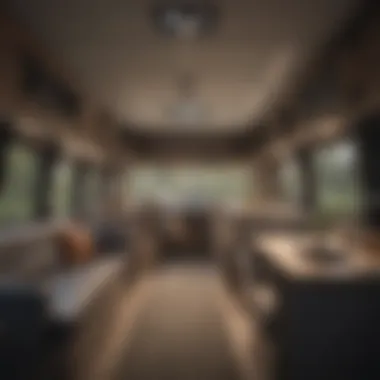A Comprehensive Guide to Frame Camper Manufacturers


Intro
The universe of frame campers leads to diverse consumer preferences and expectations. Understanding why buyers choose specific vehicles is imperative, especially in a market with extensive options. This guide will delve into the motivations behind vehicle purchases, analyze market trends, and explore innovative product offerings from various manufacturers. Our goal is to provide a comprehensive understanding of frame campers and assist potential buyers in making informed decisions.
Vehicle Purchasing Behavior
Factors Influencing Vehicle Purchases
A multitude of factors guide consumers in their choice of a frame camper. These factors can include:
- Price: The cost of the camper typically plays a crucial role. Buyers often seek a balance between affordability and features.
- Brand Reputation: Established manufacturers like Airstream, Forest River, and Winnebago attract consumers due to their established trust and quality.
- Features and Customization: Many consumers look for specific features. They want options for expansion, like additional storage or modern kitchen amenities.
- Sustainability: Today’s environmentally conscious consumers are increasingly leaning toward eco-friendly options, influencing demand for electric or hybrid campers.
Demographics of Buyers
Understanding the demographics of frame camper buyers helps manufacturers tailor their products. Notable demographic trends include:
- Millennials: This group tends to prioritize experiences over possessions, often leading them to purchase campers for travel purposes.
- Families: Parents appreciate the convenience and bonding opportunities camping provides. They look for spacious options with safety features.
- Retirees: Many retirees seek a nomadic lifestyle, using campers to explore the vast country. They often favor reliability and comfort in their choices.
Market Insights and Analysis
Consumer Behavior Analysis
Recent studies indicate shifting consumer behavior in the frame camper market. Product features that are rising in popularity include:
- Built-in technology for navigation and connectivity.
- Enhanced insulation for year-round use.
- Lightweight materials for better fuel efficiency.
Understanding these trends can help manufacturers to align new products with consumer desires.
Competitor Analysis
When evaluating competitors, it's essential to recognize distinctive attributes among manufacturers. For example:
- Airstream is known for its iconic design and durability.
- Forest River offers budget-friendly models without sacrificing quality.
- Winnebago leads in innovation and consumer-friendly designs.
Evaluating competitors helps frame a comprehensive market position. It's crucial for consumers to assess which brands meet their needs and preferences.
"Investing in a quality frame camper leads not just to immediate satisfaction but a long-term adventure."
Prolusion to Frame Campers
Frame campers are a significant segment in the realm of recreational vehicles. They offer a blend of practicality and functionality that appeals to diverse consumers, from adventure seekers to casual campers. Understanding frame campers involves grasping their unique characteristics, advantages, and historical development. This section will delve into these important factors, showcasing how they influence both the market and consumer decisions.
Defining Frame Campers
Frame campers are specialized vehicles designed for camping and travelling. They typically have a rigid framework that supports the structure, enabling durability and ease of transport. Unlike other RV types, frame campers often prioritize lightweight design combined with solid construction. This makes them suitable for varied terrains and weather conditions.
Common types of frame campers include pop-up campers, travel trailers, and truck campers. Each type has its unique features, but they all share a reliance on a strong frame that facilitates mobility without sacrificing stability. This definition is crucial for understanding how frame campers operate and their role within the larger camping community.
The Evolution of Frame Campers
The design and functionality of frame campers have evolved considerably since their inception. In the early days, campers were simple, often wooden structures that required significant manual setup. Over time, innovations in materials such as aluminum and composite plastics have transformed construction methods.
Modern frame campers often integrate advanced technologies, such as eco-friendly materials and energy-efficient systems. These advancements not only enhance user experience but also align with growing consumer preferences for sustainability. As result, frame campers are increasingly seen as versatile, appealing solutions for enjoying the outdoors while maintaining a connection to the comforts of home.


"The evolution of frame campers not only reflects technological progress but also societal shifts towards mobility and versatility in recreational activities."
In summary, an understanding of frame campers requires a focus on their definition and historical evolution. As trends shift and consumer preferences evolve, the importance of these factors continues to grow.
Market Overview
Understanding the market overview in the context of frame campers is essential for several reasons. It provides insights into current dynamics, helping buyers and manufacturers navigate the changing landscape. Key trends dictate the trajectory of the industry, influencing everything from production strategies to consumer demand. A thorough grasp of the market enables stakeholders to adapt and innovate, ensuring their offerings remain relevant and competitive.
Moreover, recognizing consumer preferences shapes product development. This alignment between what the market demands and what is being produced can result in higher customer satisfaction and sales. In this section, we will look closely at the current market trends and consumer preferences.
Current Market Trends
Market trends concerning frame campers indicate a movement towards enhanced usability and sustainability. Buyers are increasingly attracted to models that provide versatility and efficiency. Innovations in materials, such as lightweight composites and recycled elements, are gaining traction. These materials not only improve fuel efficiency but are also in line with eco-friendly practices.
Additionally, manufacturers are focusing on smart technology integration within frame campers. Features such as solar panels, advanced navigation systems, and enhanced connectivity options are becoming standard. These technologies appeal to a tech-savvy generation that values efficiency and convenience in their travel experiences.
- Lightweight materials are favored for their benefits in maneuverability.
- Sustainability practices can enhance brand loyalty.
- Smart features are crucial for modern buyers.
Consumer Preferences
Consumer preferences are shifting dramatically in the frame camper segment. Many buyers are no longer simply searching for functionality; they are also looking for an experience that aligns with their lifestyle choices. This includes preferences for environmentally responsible manufacturing and design. Consumers tend to favor brands that emphasize sustainability, reflecting a broader trend across many industries.
Moreover, customization options are increasingly important. Customers want campers that reflect their personal style and meet unique needs. Features like modular layouts and customizable interiors allow for greater personalization. Understanding these preferences allows manufacturers to tailor their offerings effectively.
"The new generation of camper buyers is looking for more than just shelter; they seek comfort, technology, and sustainability."
Top Frame Camper Manufacturers
The selection of frame camper manufacturers plays a critical role in the recreational vehicle ecosystem. Understanding the strengths and offerings of various manufacturers aids potential buyers in navigating the sometimes-overwhelming landscape of options. Leading manufacturers bring forth innovations, craftsmanship, and services that can significantly enhance the consumer experience. Moreover, the reputation and market standing of these brands often influence purchasing decisions. Buyers must consider individual features, warranties, and consumer support when evaluating their options in frame campers.
Manufacturer A: Innovations and Features
Manufacturer A stands out in the frame camper market due to its commitment to innovation. The company has integrated new technologies that enhance both functionality and user experience. Notably, their use of lightweight materials has improved fuel efficiency while maintaining structural integrity. Features such as customizable layouts and modular accessories appeal to a wide range of consumers. Additionally, the integration of smart technology allows users to control critical systems via mobile applications, ensuring convenience on the road. This dedication to innovation not only attracts tech-savvy buyers but also meets the demand for modern conveniences in outdoor adventures.
Manufacturer B: Reputation and Quality
Manufacturer B is known primarily for its strong reputation in the industry, built over decades of quality production. Consumers regard this brand as a benchmark for reliability. Product durability is a key focus, with rigorous testing for weather resistance and long-term usage. Reviews often highlight the brand's excellent after-sales service, ensuring that consumers have support long after their purchase. This focus on quality helps foster loyalty among customers, as they have confidence in their investment. Such assurance plays a crucial factor in the decision-making process for many potential buyers.
Manufacturer C: Market Position
Manufacturer C holds a significant position in the frame camper market, primarily due to its broad product range and competitive pricing. This brand offers campers that cater to both budget-conscious consumers and those seeking premium features. The diversification of their models ensures that various consumer needs are met, from simple setups to more elaborate designs. Through strategic marketing, they have established a strong presence online and at trade shows, making it easier for consumers to engage with their products. Their market strategy not only increases visibility but also helps capture a larger segment of consumers who may be new to the frame camper experience.
Material and Design Considerations
Material and design considerations hold significant weight in the realm of frame campers. These aspects not only influence the functionality and longevity of the product but also affect user experience and satisfaction. Understanding how materials work together with design elements offers potential buyers valuable insights into making informed decisions.
Materials Used in Frame Construction
Frame campers are typically constructed from a variety of materials which each bring their own benefits and practical implications. Key materials include aluminum, wood, and composite materials.
- Aluminum: Known for its lightweight and corrosion-resistant properties, aluminum is a popular choice. This material aids in improving fuel efficiency without compromising strength, making it ideal for those frequently on the road.
- Wood: Often chosen for its aesthetic appeal, wood offers a natural look. However, its weight and potential for rot pose challenges. Proper treatment and maintenance are necessary to ensure durability over time.
- Composite Materials: These materials combine both strength and lightweight characteristics. Composites often exhibit resistance to moisture and provide better insulation compared to traditional materials.
When selecting a frame camper, understanding the benefits and limitations of each material is crucial. The right material can significantly affect the camper's performance, comfort, and maintenance needs.


Design Innovations in Frame Campers
Frame camper designs have evolved dramatically due to advances in technology and shifts in consumer preferences. Recent innovations focus on enhancing usability and efficiency. Key design trends include:
- Aerodynamic Shapes: Modern campers often feature streamlined designs which help reduce wind resistance. This design aspect is essential for improving fuel efficiency, especially during travel.
- Modular Interiors: Flexibility in design allows users to customize their space based on personal needs. Modular components can be rearranged or upgraded, supporting a more efficient use of space within the camper.
- Smart Technology Integration: Increasingly, frame campers incorporate smart technology, enabling features such as remote monitoring of systems like power, water levels, and temperature controls. This innovation enhances not just convenience but also safety and resource management.
- Sustainable Design Practices: As environmental awareness grows, more manufacturers are adopting sustainable practices. This includes using recycled materials and ensuring better energy efficiency in design.
Understanding the importance of materials and innovative design can lead potential buyers to frame campers that meet both their practical needs and environmental values. Embracing new technologies and trends enhances the overall camping experience, making it more enjoyable and efficient for all.
Key Insight: Selecting a camper made from the best suited materials and innovative designs can not only improve the camping experience but also extend the life of the product.
Performance and Usability
Performance and usability are paramount when evaluating frame campers. These factors influence not only the experience of using these vehicles but also the long-term satisfaction of the owner. Key elements include driving efficiency, ease of setup, comfort, and how well the camper adapts to various conditions. Understanding these aspects is crucial for potential buyers. The performance can dictate the range of environments where campers can successfully operate, while usability affects how user-friendly and accessible the vehicle is for diverse consumers.
Understanding Performance Metrics
Performance metrics provide tangible measures to assess the capabilities of frame campers. Among the most important metrics are:
- Towing Capacity: This indicates how much weight the camper can handle when hitched to a towing vehicle. Higher towing capacities often correspond with a more robust frame, which is critical for safety and stability on roads.
- Fuel Efficiency: For many buyers, understanding fuel consumption during trips is essential. A camper that consumes less fuel can reduce overall travel costs.
- Suspension Quality: The camper’s suspension system directly impacts driving comfort and stability, especially on uneven terrain.
- Weight Distribution: Proper weight distribution ensures better handling and reduces wear on tires and other components.
These metrics not only help buyers decide among options but also reflect on the design and engineering of the camper. Researching these aspects can guide consumers toward a model that best fits their needs.
User Experience Feedback
User feedback is invaluable in gauging the overall usability of frame campers. Reviews often highlight several key areas:
- Ease of Setup: Many users appreciate designs that allow for quick and simple setup processes. Campers requiring extensive assembly can deter potential users.
- Interior Space and Layout: Feedback on how spacious and organized the interior is can vary among different campers. Buyers prefer designs that maximize comfort and convenience.
- Technology Integration: Advanced features, such as smart controls for lights and appliances, receive both praise and criticism. Consumers today often seek tech-savvy options that integrate seamlessly into their camping routines.
- Durability and Reliability: Owners frequently share their insights on how well their campers withstand various conditions. Longevity is a sign of quality manufacturing.
"User reviews often reveal essential insights that technical specifications alone cannot provide."
By paying attention to user experiences, potential buyers can make more informed decisions based on real-world applications rather than solely on theoretical performance data.
Sustainability in Frame Camper Manufacturing
Sustainability is not just a buzzword in today's manufacturing world; it is a crucial consideration for frame camper manufacturers. As consumers become increasingly conscious of their environmental impact, the demand for eco-friendly products grows. Frame campers, which often face rough usage and varied conditions, must integrate sustainable practices without compromising quality and performance. Thus, understanding the intersection between camper design and sustainability has become essential for manufacturers aiming to remain competitive.
Eco-friendly Practices
Eco-friendly practices in frame camper manufacturing encompass a broad range of strategies. Many manufacturers now prioritize sourcing materials that are either recycled or sustainably harvested. For example, using aluminum and composite materials not only reduces weight for better fuel efficiency but also minimizes the overall carbon footprint. These materials are typically more durable and resistant to corrosion and environmental damage, which enhances the longevity of the campers and leads to fewer replacements over time.
In addition to materials, energy-efficient production methods have gained traction. Facilities are adopting solar power and other renewable energy sources to minimize emissions during manufacturing. This shift leads not only to lower operational costs but also aligns with a commitment to environmental stewardship. Another important practice involves waste reduction initiatives, where leftover materials from production processes are either recycled or repurposed, rather than sent to landfills.
Some manufacturers also focus on the entire lifecycle of the camper, ensuring that end-of-life disposals can be managed sustainably. By developing products that can be easily disassembled, manufacturers allow for reuse or recycling of individual components, thereby reducing overall waste.
"The shift towards sustainability is not just a trend; it is reshaping the future of frame camper manufacturing. Companies that adapt will lead the way."
Long-term Durability and Sustainability
Long-term durability plays a significant role in the sustainability narrative of frame campers. A camper that withstands years of use reduces the need for replacements, thus lowering overall environmental impact. Manufacturers are increasingly investing in research and development to create products that not only perform well but also last longer under diverse conditions.
The use of durable materials, combined with advanced engineering and design innovations, means that modern frame campers are better equipped to handle the rigors of outdoor adventures. For example, campers with improved insulation do not just provide comfort; they can also contribute to energy efficiency by regulating temperature without excessive use of heating or cooling.
Moreover, long-term sustainability can be linked to the ability of these campers to retain resale value, as consumers are often drawn to products with proven durability. This ongoing demand encourages manufacturers to commit to quality, further enhancing sustainable practices throughout the entire production line.


Regulatory Considerations
Regulatory considerations play a crucial role in the development, manufacturing, and sale of frame campers. These regulations are designed to protect consumers and ensure that the products meet safety and quality standards. Understanding these regulations is essential for both manufacturers and consumers. Compliance with established guidelines can prevent accidents, enhance vehicle performance, and foster a safer camping experience.
Compliance with Safety Standards
The compliance with safety standards is a vital part of the manufacturing process for frame campers. Organizations such as the National Highway Traffic Safety Administration (NHTSA) in the United States set forth stringent requirements that manufacturers must follow. These standards cover various aspects, including structural integrity, braking systems, and overall vehicle safety features.
For instance, frame campers must pass crash testing and meet specified guidelines that ensure they can withstand collisions. This enhances the overall safety for occupants. Additionally, equipment failures can lead to severe accidents. Thus, adhering to safety standards minimizes risks and protects consumers.
Moreover, these safety checks are not one-time processes; they require ongoing evaluation and adjustment as technology evolves. Manufacturers have a responsibility to stay updated on current regulations to maintain compliance. This diligent approach not only safeguards customers but also strengthens brand trust in the market.
Consumer Protection Regulations
Consumer protection regulations are another critical aspect of the frame camper industry. These regulations aim to ensure that consumers are treated fairly and that their rights are protected when purchasing a frame camper. Such regulations generally cover warranty requirements, deceptive marketing practices, and product safety information.
For example, manufacturers must provide clear information about warranties so that consumers know what is covered and what is not. This transparency can make a significant difference when a buyer needs repairs or replacements.
Additionally, regulations prevent manufacturers from misleading consumers with false advertising or unverifiable claims about their products. Consumers are entitled to receive accurate information regarding the features and performance capabilities of frame campers, helping them make informed purchasing decisions.
According to experts, upholding consumer protection regulations not only builds trust with customers but also helps manufacturers to avoid legal issues and penalties.
In summary, regulatory considerations, including compliance with safety standards and consumer protection regulations, are integral to the frame camper industry. These regulations ensure safety, build trust, and protect consumers, while also guiding manufacturers in responsible production practices.
Future Trends in Frame Campers
The landscape of frame campers is set to undergo significant transformations in the coming years. Understanding future trends in this segment is crucial for various stakeholders. This includes manufacturers aiming to innovate, consumers looking for the best options, and investors analyzing market potential. Adapting to these trends ensures that companies remain competitive and can meet the evolving needs of an increasingly sophisticated consumer base.
Notably, the intersection of technology, environmental concerns, and consumer preferences is driving these changes. These factors are not only reshaping the durability and functionality of frame campers but also influencing their overall design and usage.
Technological Advancements
Technological advancements hold a dominant position in shaping the future of frame campers. Innovations in materials science, smart technologies, and energy efficiency will redefine product offerings.
- Smart Features: Modern frame campers now incorporate smart technologies such as app-controlled appliances and integrated navigation systems. These advancements enhance user experience, providing convenience that traditional campers lacked.
- Autonomous Systems: As autonomous driving technology evolves, frame campers might integrate features that enhance safety and ease of use. This could include automated parking systems and lane-assist technologies that make camping a seamless experience.
- Sustainable Technologies: The shift towards sustainability pushes manufacturers to invest in solar panels, energy storage systems, and eco-friendly materials. These tech advancements not only cater to environmentally conscious consumers but also promise lower operating costs in the long run.
"The future of camping is not only about escaping but about embracing technology to enhance that experience."
Changing Consumer Demands
Consumer behavior is fundamentally shifting, driven by lifestyle changes and heightened awareness about environmental issues. The demand for frame campers that reflect these changes is rising.
- Customization: Today's consumers favor personalized solutions. They want options that reflect individual preferences, from layout design to interior fixtures. This trend encourages manufacturers to offer customizable camper models.
- Eco-Friendly Options: Consumers increasingly prefer products that minimize impact on the environment. This includes a preference for durable materials and energy-efficient practices during manufacturing.
- Focus on Experiences: Consumers are now prioritizing experiences over possessions. They look for campers that enhance their outdoor activities, such as models designed for specific adventures like off-roading or extended camping trips.
As a result, companies that align with these trends are more likely to attract and retain customers. Recognizing the synergy between technological enhancements and changing consumer preferences will be essential for manufacturers seeking to thrive in this competitive market.
End
The topic of frame campers is not just a passing trend in the world of recreational vehicles. It encapsulates important elements that appeal to diverse user preferences and innovations shaping the industry. Understanding this topic is crucial, as it allows potential buyers to navigate their options effectively, ensuring they make informed decisions that align with their needs and expectations.
Summarizing Key Insights
Throughout this article, we have explored many aspects of frame campers. Key insights include the evolution of frame campers from rudimentary designs to modern, sophisticated vehicles. Manufacturers have embraced new materials and technologies that enhance performance, durability, and user experience. Eco-friendly practices have gained traction, reflecting consumer awareness regarding sustainability. Additionally, compliance with safety standards protects consumers and fosters trust in the market.
Guidance for Potential Buyers
For potential buyers, several factors warrant careful consideration when selecting a frame camper:
- Define Your Needs: Assess what you plan to use the camper for, be it weekends away, long road trips, or family camping. This assessment will guide your eventual choice.
- Research Manufacturers: Look into various manufacturers' reputations. Understanding their history, customer feedback, and product quality can help you find a reliable option.
- Explore Features: Evaluate the unique features offered by different models. For instance, some campers prioritize lightweight designs, while others focus on enhanced interior space.
- Stay Informed About Regulations: Being aware of local regulations related to RVs can guide you in choosing the right camper that meets regional requirements.
- Consider Resale Value: Analyzing the depreciation rates of specific brands can offer insights into potential future value, which is important for long-term planning.















